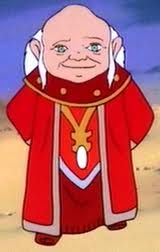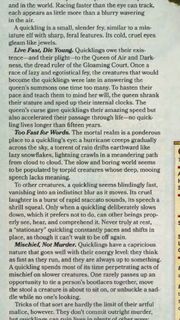- 253
- 14
This might turn into a content revision later but I want to know if we have answers to these questions right now beforehand.
1. Does having higher mental stats grant resistances to certain effects?
I ask this because a lot of the spells that do things like create illusions, BFR, modify memory, destroy minds, etc. use saving throws that require mental stats (Intelligence, Wisdom, and Charisma).
As an example, in the lore of D&D a Deva is a messenger of the Gods and as such is resistant to deceptions (magical or not) and stay in the realm until their job is done. This is reflected by giving them a high Wisdom save and a high Charisma save.
Personally, I think it should apply but it could also be considered game mechanics.
2. How do we handle Anti-Magic field?
I want to get this out of the way now so we don't end up with any "this is what it can do in one edition, but this edition says this" stuff. It nullifies magic. That much is obvious. What differs is what else it nullifies from each edition.
In 1st and 2nd edition, it nullified practically all special attacks (the examples being Dragon's breath, voice attacks, and Gaze attacks).
"By means of this spell, the wizard surrounds himself with an invisible barrier that moves with him. The space within this barrier is totally impervious to all magic and magical spell effects, thus preventing the passage of spells or their effects. Likewise, it prevents the functioning of any magical items or spells within its confines. The area is also impervious to breath weapons, gaze or voice attacks, and similar special attack forms."
In 3rd edition, it blocked Magic, Spells, Spell-like effects (basically abilities that replicated spells), and Supernatural abilities (like Dragon's Breath, Spell Immunity, and Energy Drain). It didn't stop natural but inhuman abilities like a troll's Regenerationn.
"An invisible barrier surrounds the character and moves with the character. The space within this barrier is impervious to most magical effects, including spells, spell-like abilities, and supernatural abilities. Likewise, it prevents the functioning of any magic items or spells within its confines."
I'm skipping 4th edition because (as far as I know) it doesn't exist in that edition.
5th edition is probably the simplest and the one that prevents the least amount of things. It prevents magical effects from happening in it. That's it. So that counts towards magic items, spells, spell-like effects, psionics, and some parts of Ki. The difference is that in this edition it is specifically stated to not stop supernatural abilities like a dragon's breath attack.
"Within the Sphere, Spells can't be cast, summoned creatures disappear, and even Magic Items become mundane. Until the spell ends, the Sphere moves with you, centered on you.
Spells and other magical effects, except those created by an artifact or a deity, are suppressed in the Sphere and can't protrude into it. A slot expended to cast a suppressed spell is consumed. While an effect is suppressed, it doesn't function, but the time it spends suppressed counts against its Duratio."
So my question is do we use a composite version of it in fights? Do we use only the nerfed version from 5e? Do we use some amalgamation of it?
TL R: Do high mental stats grant resistances and what do we use for the Anti-Magic field?
R: Do high mental stats grant resistances and what do we use for the Anti-Magic field?
1. Does having higher mental stats grant resistances to certain effects?
I ask this because a lot of the spells that do things like create illusions, BFR, modify memory, destroy minds, etc. use saving throws that require mental stats (Intelligence, Wisdom, and Charisma).
As an example, in the lore of D&D a Deva is a messenger of the Gods and as such is resistant to deceptions (magical or not) and stay in the realm until their job is done. This is reflected by giving them a high Wisdom save and a high Charisma save.
Personally, I think it should apply but it could also be considered game mechanics.
2. How do we handle Anti-Magic field?
I want to get this out of the way now so we don't end up with any "this is what it can do in one edition, but this edition says this" stuff. It nullifies magic. That much is obvious. What differs is what else it nullifies from each edition.
In 1st and 2nd edition, it nullified practically all special attacks (the examples being Dragon's breath, voice attacks, and Gaze attacks).
"By means of this spell, the wizard surrounds himself with an invisible barrier that moves with him. The space within this barrier is totally impervious to all magic and magical spell effects, thus preventing the passage of spells or their effects. Likewise, it prevents the functioning of any magical items or spells within its confines. The area is also impervious to breath weapons, gaze or voice attacks, and similar special attack forms."
In 3rd edition, it blocked Magic, Spells, Spell-like effects (basically abilities that replicated spells), and Supernatural abilities (like Dragon's Breath, Spell Immunity, and Energy Drain). It didn't stop natural but inhuman abilities like a troll's Regenerationn.
"An invisible barrier surrounds the character and moves with the character. The space within this barrier is impervious to most magical effects, including spells, spell-like abilities, and supernatural abilities. Likewise, it prevents the functioning of any magic items or spells within its confines."
I'm skipping 4th edition because (as far as I know) it doesn't exist in that edition.
5th edition is probably the simplest and the one that prevents the least amount of things. It prevents magical effects from happening in it. That's it. So that counts towards magic items, spells, spell-like effects, psionics, and some parts of Ki. The difference is that in this edition it is specifically stated to not stop supernatural abilities like a dragon's breath attack.
"Within the Sphere, Spells can't be cast, summoned creatures disappear, and even Magic Items become mundane. Until the spell ends, the Sphere moves with you, centered on you.
Spells and other magical effects, except those created by an artifact or a deity, are suppressed in the Sphere and can't protrude into it. A slot expended to cast a suppressed spell is consumed. While an effect is suppressed, it doesn't function, but the time it spends suppressed counts against its Duratio."
So my question is do we use a composite version of it in fights? Do we use only the nerfed version from 5e? Do we use some amalgamation of it?
TL

